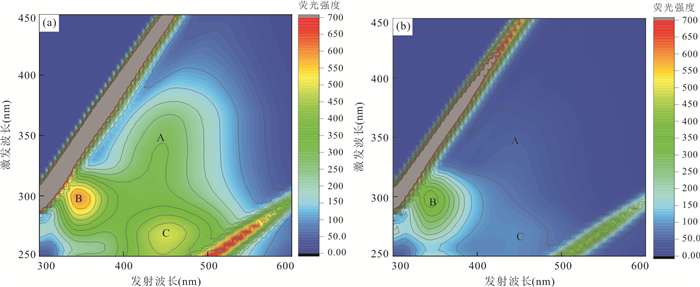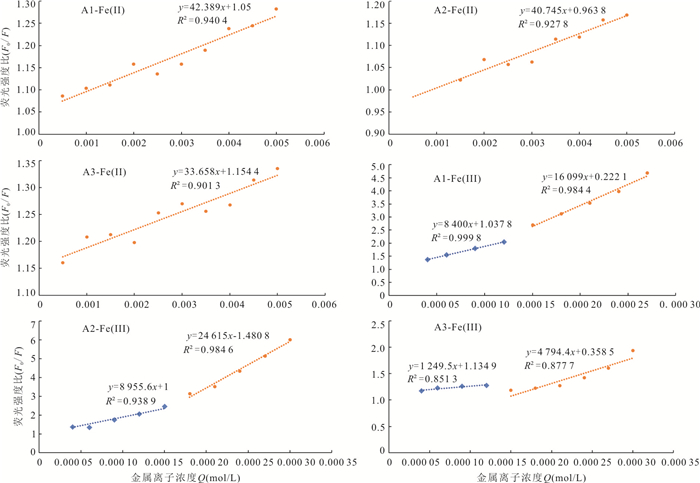Stability of Organic Iron Complexes in Dajiuhu Peats and Its Ecological Significance
-
摘要: 为了研究泥炭沼泽源铁有机配合物的络合稳定性,利用pH电位滴定法和荧光淬灭滴定法测定了大九湖泥炭沼泽中不同分子量段的DOM和Fe2+、Fe3+的络合稳定常数.pH电位滴定法结果(4.0~6.1)和荧光淬灭滴定法(1.5~4.1)差异较大,这与高pH条件下OH被脱质子化及Fe2+的氧化有关.相对而言,pH滴定法更适用于探究不同分子量段DOM与铁的络合稳定性,荧光淬灭法不改变样品酸碱条件,更适于研究不同价态铁与DOM的络合稳定性.研究结果表明:DOM与Fe3+的络合稳定常数大于Fe2+,低分子量段(< 3 kDa)的DOM与Fe2+、Fe3+的络合稳定常数更大.泥炭沼泽源铁有机配合物具有较好的络合稳定性,分子量相对较小的DOM与铁的络合能力更强.即便Fe2+氧化为Fe3+,仍能与DOM络合并保持较强的稳定性,这有利于陆源溶解性铁向水生态系统的输出.沼泽源铁有机配合物的络合稳定性还会影响铁的生物可利用性.Abstract: In order to study the complexing stability of organic iron complexes from peat, the stability of DOM-Fe2+, Fe3+ in different molecular weights of Dajiuhu peatland was determined by potentiometric titration and fluorescence quenching titration. There are obvious differences between the results of potentiometric titration (4.0-6.1) and fluorescence quenching titration (1.5-4.1), which can be explained by the deprotonation of OH in high pH value and the oxidation of Fe2+ during the experiments. Potentiometric titration is suitable for studying the complexing stability of different molecular weights of DOM-Fe; the pH would not change during the experiment using fluorescence quenching titration method. Thus, the fluorescence method can be well applied to the element of variable valency. The results show that the complexing stability constants of DOM-Fe3+ is higher than that of Fe2+, and that of low-molecular-weight DOM with Fe2+ and Fe3+ is higher. The experiment indicates that high stability of DOM-Fe in peat, and relatively low-molecular-weight DOM has stronger ability to complex iron. Even Fe2+ is oxidized to Fe3+, it can still complex with DOM stably, which is conducive to the output of terrestrial dissolved iron to aquatic ecosystem. The complexing stability of iron organic complexes from peat will also affect the bioavailability of iron.
-
表 1 泥炭DOM的TOC和总酚含量
Table 1. TOC and total phenol content of DOM from peat
样品编号 TOC(mg/L) 总酚(mg/L) A1 30.62 1.12 A2 6.20 1.03 A3 14.02 2.46 B1 8.81 0.58 B2 2.45 0.42 B3 3.91 0.87 C1 2.20 0.48 C2 1.82 0.46 C3 2.93 0.50 表 2 泥炭不同分子量段DOM的加质子常数对数值
Table 2. Logarithm of proton addition constant of DOM in different molecular weight segments of peat
样品编号 A1 A2 A3 B1 B2 B3 C1 C2 C3 lgKH 5.42 5.39 4.93 4.95 5.47 5.29 4.02 4.83 4.67 表 3 pH电位滴定法测得不同分子量段泥炭DOM与Fe2+、Fe3+的络合稳定常数对数值(lgK)
Table 3. Logarithm of complexing stability constants of DOM, Fe2+, Fe3+ in different molecular weight segments of peat measured by potentiometric titration
金属离子 样品编号 A1 A2 A3 B1 B2 B3 C1 C2 C3 Fe2+ 5.27 4.93 4.07 4.34 4.60 4.37 4.01 4.50 4.46 Fe3+ 5.81 5.75 4.83 5.45 6.10 5.70 4.51 5.57 5.32 表 4 荧光淬灭法测得的DOM与不同金属离子的lgK值
Table 4. lgK of DOM-metal ions measured by fluorescence quenching method
样品编号 Fe2+ Fe3+ A1 1.63 3.92 A2 1.61 3.96 A3 1.53 3.68 B1 1.61 4.35 B2 1.50 4.32 B3 1.46 3.93 C1 1.53 4.20 C2 1.65 4.36 C3 1.59 4.30 -
Baker, A., 2001. Fluorescence Excitation-Emission Matrix Characterization of Some Sewage-Impacted Rivers. Environmental Science & Technology, 35(5): 948-953. https://doi.org/10.1021/es000177t http://europepmc.org/abstract/med/11351540 Bao, X. M., 1987. Stability Constants of Fe(Ⅱ)- and Mn(Ⅱ)-Complexes in Relation to the Molecular Weight of Complexing Agents. Acta Pedologica Sinica, 24(4): 313-317 (in Chinese with English abstract). http://pedologica.issas.ac.cn/trxben/ch/reader/view_abstract.aspx?file_no=19870403&flag=1 Bao, X. M., Yu, T. R., 1978. Studies on Oxidation-Reduction Processes in Panddy Soils Ⅶ: Characterization of the Water-Soluble Ferrous Iron. Acta Pedologica Sinica, 15(1): 13-22 (in Chinese with English abstract). Biller, D. V., Bruland, K.W., 2014. The Central California Current Transition Zone: A Broad Region Exhibiting Evidence for Iron Limitation. Progress in Oceanography, 120(1): 370-382. https://doi.org/10.1016/j.pocean.2013.11.002 http://www.sciencedirect.com/science/article/pii/S0079661113002218 Boguta, P., Sokołowska, Z., 2016. Interactions of Zn(Ⅱ) Ions with Humic Acids Isolated from Various Type of Soils. Effect of pH, Zn Concentrations and Humic Acids Chemical Properties. PLoS One, 11(4): e0153626. https://doi.org/10.1371/journal.pone.0153626 Bundy, R. M., Abdulla, H. A. N., Hatcher, P. G., et al., 2015. Iron-Binding Ligands and Humic Substances in the San Francisco Bay Estuary and Estuarine-Influenced Shelf Regions of Coastal California. Marine Chemistry, 173: 183-194. doi: 10.1016/j.marchem.2014.11.005 Cabaniss, S. E., 1992. Synchronous Fluorescence Spectra of Metal-Fulvic Acid Complexes. Environmental Science & Technology, 26(6): 1133-1139. https://doi.org/10.1021/es50002a018 doi: 10.1021/es50002a018 Campitelli, P. A., Velasco, M. I., Ceppi, S. B., 2006. Chemical and Physicochemical Characteristics of Humic Acids Extracted from Compost, Soil and Amended Soil. Talanta, 69(5): 1234-1239. https://doi.org/10.1016/j.talanta.2005.12.048 Chen, W., Westerhoff, P., Leenheer, J. A., et al., 2003. Fluorescence Excitation-Emission Matrix Regional Integration to Quantify Spectra for Dissolved Organic Matter. Environmental Science & Technology, 37(24): 5701-5710. https://doi.org/10.1021/es034354c doi: 10.1021/es034354c Coble, P. G., 1996. Characterization of Marine and Terrestrial DOM in Seawater Using Excitation-Emission Matrix Spectroscopy. Marine Chemistry, 51(4): 325-346. https://doi.org/10.1016/0304-4203(95)00062-3 Elkins, K. M., Nelson, D. J., 2001. Fluorescence and FT-IR Spectroscopic Studies of Suwannee River Fulvic Acid Complexation with Aluminum, Terbium and Calcium. Journal of Inorganic Biochemistry, 87(1/2): 81-96. https://doi.org/10.1016/s0162-0134(01)00318-x http://onlinelibrary.wiley.com/resolve/reference/PMED?id=11709217 Fu, P., Wu, F., Liu, C., et al., 2007. Fluorescence Characterization of Dissolved Organic Matter in an Urban River and Its Complexation with Hg (Ⅱ). Applied Geochemistry, 22(8): 1668-1679. https://doi.org/10.1016/j.apgeochem.2007.03.041 Fu, P. Q., Liu, C. Q., Wu, F. C., 2004. Three-Dimensional Excitation Emission Matrix Fluorescence Spectroscopic Characterization of the Complexation between Mercury (Ⅱ) and Dissolved Organic Matter. Enviromental Science, 25(6): 140-144 (in Chinese with English abstract) http://www.ncbi.nlm.nih.gov/pubmed/15759899 Gondar, D., Lopez, R., Fiol, S., et al., 2005. Characterization and Acid-Base Properties of Fulvic and Humic Acids Isolated from Two Horizons of an Ombrotrophic Peat Bog. Geoderma, 126(3-4): 367-374. doi: 10.1016/j.geoderma.2004.10.006 Han, N., Thompson, M.L., 1999. Copper-Binding Ability of Dissolved Organic Matter Derived from Anaerobically Digested Biosolids. Journal of Environment Quality, 28(3): 939. https://doi.org/10.2134/jeq1999.00472425002800030026x http://dl.sciencesocieties.org/publications/jeq/abstracts/28/3/JEQ0280030939 Hernandez, D., Plaza, C., Senesi, N., et al., 2006. Detection of Copper (Ⅱ) and Zinc (Ⅱ) Binding to Humic Acids from Pig Slurry and Amended Soils by Fluorescence Spectroscopy. Environmental Pollution, 143(2): 212-220. https://doi.org/10.1016/j.envpol.2005.11.038 Huang, J. L., Sun, D. W., Ma, X. L., et al., 1992. Studies on Protonation Constants and Coordination Compounds Stability Constants of Tannins. Journal of Nanjing Forestry University, 16(1): 13-18 (in Chinese with English abstract). http://en.cnki.com.cn/Article_en/CJFDTOTAL-NJLY199201002.htm Huang, X. Y., Zhang, Z. Q., Wang, H. M., et al., 2017. Overview on Critical Zone Observatory at Dajiuhu Peatland, Shennongjia. Earth Science, 42(6): 1026-1038 (in Chinese with English abstract). Janoš, P., Kříženecká, S., Madronová, L., 2008. Acid-Base Titration Curves of Solid Humic Acids. Reactive and Functional Polymers, 68(1): 242-247. doi: 10.1016/j.reactfunctpolym.2007.09.005 Kondo, Y., Takeda, S., Furuya, K., 2012. Distinct Trends in Dissolved Fe Speciation between Shallow and Deep Waters in the Pacific Ocean. Marine Chemistry, 134-135: 18-28. https://doi.org/10.1016/j.marchem.2012.03.002 Krachler, R., Jirsa, F., Ayromlou, S., 2005. Factors Influencing the Dissolved Iron Input by River Water to the Open Ocean. Biogeosciences Discussions, 2(3): 311-315. https://doi.org/10.5194/bg-2-311-2005 Kuhn, K. M., Maurice, P. A., Neubauer, E., et al., 2014. Accessibility of Humic-Associated Fe to a Microbial Siderophore: Implications for Bioavailability. Environmental Science & Technology, 48(2): 1015-1022. https://doi.org/10.1021/es404186v doi: 10.1021/es404186v Lu, X., Jaffe, R., 2001. Interaction between Hg (Ⅱ) and Natural Dissolved Organic Matter: A Fluorescence Spectroscopy Based Study. Water Research, 35(7): 1793-1803. https://doi.org/10.1016/S0043-1354(00)00423-1 Morel, F.M.M., Hudson, R.J.M., Price, N.M., 1991. Limitation of Productivity by Trace Metals in the Sea. Limnology and Oceanography, 36(8): 1742-1755. https://doi.org/10.4319/lo.1991.36.8.1742 Orlowska, E., Roller, A., Pignitter, M., et al., 2017. Synthetic Iron Complexes as Models for Natural Iron-Humic Compounds: Synthesis, Characterization and Algal Growth Experiments. The Science of the Total Environment, 577: 94-104. https://doi.org/10.1016/j.scitotenv.2016.10.109 Qin, X. Q., Yao, B., Jin, L., et al., 2020. Characterizing Soil Dissolved Organic Matter in Typical Soils from China Using Fluorescence EEM-PARAFAC and UV-Visible Absorption. Aquatic Geochemistry, 26(1): 71-88. https://doi.org/10.1007/s10498-019-09366-7 Shin, H.S., Hong, K.H., Lee, M.H., et al., 2001. Fluorescence Quenching of Three Molecular Weight Fractions of a Soil Fulvic Acid by UO2(Ⅱ). Talanta, 53(4): 791-799. https://doi.org/10.1016/s0039-9140(00)00567-1 doi: 10.1016/S0039-9140(00)00567-1 Song, F., Wu, F., Guo, F., et al., 2017. Interactions between Stepwise-Eluted Sub-Fractions of Fulvic Acids and Protons Revealed by Fluorescence Titration Combined with EEM-PARAFAC. The Science of the Total Environment, 605/606: 58-65. https://doi.org/10.1016/j.scitotenv.2017.06.164 Stevenson, F.J., Krastanov, S.A., Ardakani, M. S., 1973. Formation Constants of Cu2+ Complexes with Humic and Fulvic Acids. Geoderma, 9(2): 129-141. https://doi.org/10.1016/0016-7061(73)90048-7 Wang, R. C., Wang, H. M., Xiang, X., et al., 2018a. Temporal and Spatial Variations of Microbial Carbon Utilization in Water Bodies from the Dajiuhu Peatland, Central China. Journal of Earth Science, 29(4): 969-976. https://doi.org/10.1007/s12583-017-0818-5 Wang, Y., Xiang, W., Yang, W., et al., 2018b. Photo-Stability of Iron-Phenolic Complexes Derived from Peatland Upon Irradiation in Waters under Simulated Sunlight. Chemical Geology, 485: 14-23. https://doi.org/10.1007/s12583-017-0818-5 doi: 10.1016/j.chemgeo.2018.03.016 Wells, M.L., Zorkin, N.G., Lewis, A.G., 1983. The Role of Colloid Chemistry in Providing a Source of Iron to Phytoplankton. Journal of Marine Research, 41(4): 731-746. https://doi.org/10.1357/002224083788520478 Witter, A.E., Luther, G.W., 1998. Variation in Fe-Organic Complexation with Depth in the Northwestern Atlantic Ocean as Determined Using a Kinetic Approach. Marine Chemistry, 62(3): 241-258. https://doi.org/10.1016/s0304-4203(98)00044-9 http://www.sciencedirect.com/science/article/pii/S0304420398000449 Wu, F. C., Tanoue, E., 2001. Isolation and Partial Characterization of Dissolved Copper-Complexing Ligands in Streamwaters. Environmental Science & Technology, 35(18): 3646-3652. https://doi.org/10.1021/es0019023 http://www.ncbi.nlm.nih.gov/pubmed/11783640 Wu, Y., Xiang, W., Fu, X. F., et al., 2016. Geochemical Interactions between Iron and Phenolics Originated from Peatland in Hani, China: Implications for Effective Transport of Iron from Terrestrial Systems to Marine. Environmental Earth Sciences, 75(4): 1-12. https://doi.org/10.1007/s12665-015-5189-6 Yang, C. W., 2004. Complexation of Cu2+, Zn2+ and Fe2+ Metal Ions with Humic. Journal of Gansu Lianhe University, 18(3): 45-48 (in Chinese with English abstract). http://en.cnki.com.cn/Article_en/CJFDTOTAL-GXJB200403016.htm Yang, W. L., Xiang, W., Wang, Y. L., et al., 2018. Disolution of Fe-Organic Asociations by Peatland-Derived Phenolic Acids and Its Environmental Significance. Earth Science, 43(11): 256-265 (in Chinese with English abstract). 保学明, 1987. 铁锰络合物的稳定常数与有机络合剂的分子量的关系. 土壤学报, 24(4): 313-317. https://www.cnki.com.cn/Article/CJFDTOTAL-TRXB198704003.htm 保学明, 于天仁, 1978. 水稻土中氧化还原过程的研究: Ⅷ. 水溶态亚铁的区分. 土壤学报, 15(1): 13-22. https://www.cnki.com.cn/Article/CJFDTOTAL-TRXB195704002.htm 傅平青, 刘丛强, 吴丰昌, 2004. 三维荧光光谱研究溶解有机质与汞的相互作用. 环境科学, 25(6): 140-144. doi: 10.3321/j.issn:0250-3301.2004.06.029 黄剑朎, 孙达旺, 马信亮, 等, 1992. 单宁加质子常数及其配合物稳定常数的研究. 南京林业大学学报(自然科学版), 16 (1): 13-18. https://www.cnki.com.cn/Article/CJFDTOTAL-NJLY199201002.htm 黄咸雨, 张志麒, 王红梅, 等, 2017. 神农架大九湖泥炭湿地关键带监测进展. 地球科学, 42(6): 1026-1038. doi: 10.3799/dqkx.2017.081 杨春文, 2004. 腐殖酸与Cu2+、Zn2+、Fe3+的络合作用. 甘肃联合大学学报, 18(3): 45-48. doi: 10.3969/j.issn.1672-691X.2004.03.016 杨渭林, 向武, 汪亦柳, 等, 2018. 泥炭沼泽源酚酸对铁有机复合体的溶解作用及其环境意义. 地球科学, 43(11): 4056-4065. doi: 10.3799/dqkx.2018.289 -










 下载:
下载:



